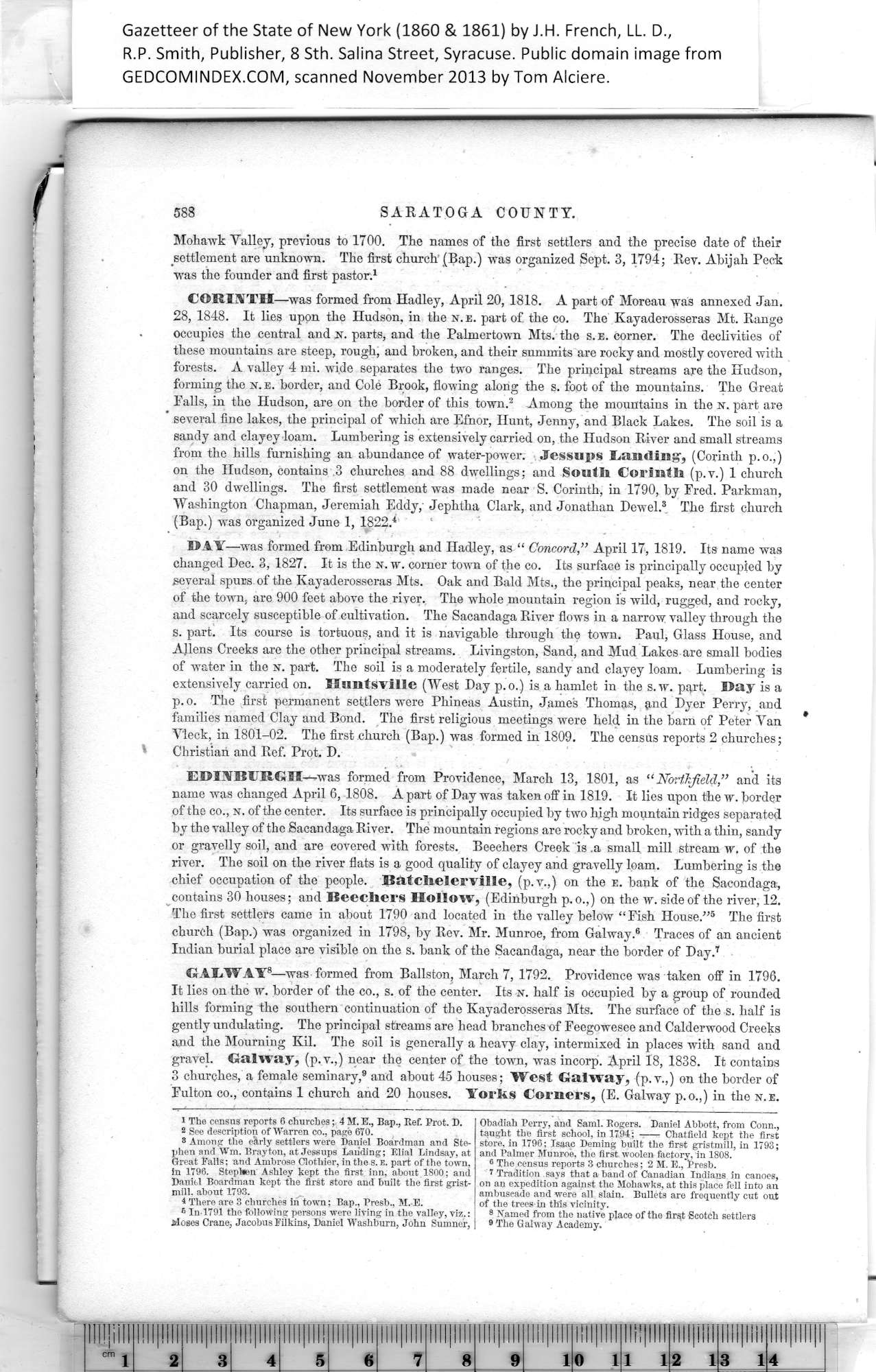|
588 SARATOGA COUNTY.
Mohawk Yalley, previous to 1700. The names of the first settlers and the precise date of their
settlement are unknown. The first church'(Bap.) was organized Sept. 3, 1794; Rev. Abijah Peck
was the founder and first pastor.1
CGsE-IYTH—was formed from Hadley, April 20, 1818. A part of Moreau was annexed Jan.
28, 1848. It lies upon the Hudson, in the n.e. part of the co. The Kayaderosseras Mt. Range
occupies the central and n. parts, and the Palmertown Mts. the s. e. corner. The declivities of
these mountains are steep, rough, and broken, and their summits are rocky and mostly covered with
forests. A valley 4 mi. wide separates the two ranges. The principal streams are the Hudson,
forming the n.e. border, and Cole Brook, flowing along the s. foot of the mountains. The Great
Falls, in the Hudson, are on the border of this town.2 Among the mountains in the n. part are
several fine lakes, the principal of which are Efnor, Hunt, Jenny, and Black Lakes. The soil is a
sandy and clayey loam. Lumbering is extensively carried on, the Hudson River and small streams
from the hills furnishing an abundance of water-power. Jessups Baudiug', (Corinth p.o.,)
on the Hudson, contains 3 churches and 88 dwellings; and Soutk Coriiatfa (p.v.) 1 church
and 30 dwellings. The first settlement was made near S. Corinth, in 1790, by Fred. Parkman,
Washington Chapman, Jeremiah Eddy, Jephtha Clark, and Jonathan Dewel.3 The first church
(Bap.) was organized June 1, 1822.4
BAY—was formed from Edinburgh and Hadley, as “ ConcordApril 17, 1819. Its name was
changed Dec. 3, 1827. It is the n. w. corner tovvn of the co. Its surface is principally occupied by
several spurs of the Kayaderosseras Mts. Oak and Bald Mts., the principal peaks, near the center
of the town, are 900 feet above the river. The whole mountain region is wild, rugged, and rocky,
and scarcely susceptible of cultivation. The Sacandaga River flows in a narrow valley through the
s. part. Its course is tortuous, and it is navigable through the town. Paul, Glass House, and
Allens Creeks are the other principal streams. Livingston, Sand, and Mud Lakes are small bodies
of water in the n. part. The soil is a moderately fertile, sandy and clayey loam. Lumbering is
extensively carried on. Huntsville (West Day p.o.) is a hamlet in the s.w. part. Bay is a
p. o. The first permanent settlers were Phineas Austin, James Thomas, and Dyer Perry, and
families named Clay and Bond. The first religious meetings were held in the barn of Peter Yan *
Yleck, in 1801-02. The first church (Bap.) was formed in 1809. The census reports 2 churches;
Christian and Ref. Prot, D.
EBianBURGH—was formed from Providence, March 13, 1801, as “ NortTifield,” and its
name was changed April 6, 1808. A part of Day was taken off in 1819. It lies upon the w. border
of the co., n. of Die center. Its surface is principally occupied by two high mountain ridges separated
by the valley of the Sacandaga River. The mountain regions are rocky and broken, with a thin, sandy
or gravelly soil, and are covered with forests. Beechers Creek is .a small mill stream w. of the
river. The soil on the river flats is a good quality of clayey and gravelly loam. Lumbering is the
chief occupation of the people. Batclielerville, (p.v.,) on the e. bank of the Sacondaga,
^contains 30 houses; and Beecliers Hollow, (Edinburgh p. o.,) on the w. side of the river, 12.
The first settlers came in about 1790 and located in the valley below “Fish House.”5 The first
church (Bap.) was organized in 1798, by Rev. Mr. Munroe, from Galway.4 Traces of an ancient
Indian burial place are visible on the s. bank of the Sacandaga, near the border of Day.7
GALWAY8—was formed from Ballston, March 7, 1792. Providence was taken off in 1796.
It lies on the w. border of the co., s. of the center. Its n. half is occupied by a group of rounded
hills forming the southern continuation of the Kayaderosseras Mts. The surface of the s. half is
gently undulating. The principal streams are head branches of Feegowesee and Calderwood Creeks
and the Mourning Kil. The soil is generally a heavy clay, intermixed in places with sand and
gravel. Galway, (p.v.,) near the center of the town, was incorp. April 18, 1838. It contains
3 churches, a female seminary,9 and about 45 houses; West Galway, (p.v.,) on the border of
Fulton co., contains 1 church and 20 houses. Yorks Corners, (E. Galway p.o.,) in the n.e.
|
Obadiah Perry, and Sami. Rogers. Daniel Abbott, from Conn.,
taught the first school, in 1794; - Chatfield kept the first
store, in 1796; Isaac Deming built the first gristmill, in 1793;
and Palmer Munroe, the first woolen factory, in 1808.
6 The census reports 3 churches; 2 M. E., Presb.
7 Tradition says that a band of Canadian Indians in canoes,
on an expedition against the Mohawks, at this place fell into an
ambuscade and were all slain. Bullets are frequently cut out
of the trees in this vicinity.
8 Named from the native place of the first Scotch settlers
2 The Galway Academy. |
1
The census reports 6 churches; 4 M. E., Bap., Ref. Prot. D.
2
See description of Warren CO., page 670.
3
8 Among the early settlers were Daniel Boardman and Ste¬
phen and Wm. Brayton, at Jessups Landing; Elial Lindsay, at
Great Falls; and Ambrose Clothier, in the s. e. part of the town,
in 1796. Stephen Ashley kept the first inn, about 1800; and
Daniel Boardman kept the first store and built the first grist¬
mill. about 1793.
4
Moses Crane, Jacobus FOkins, Daniel Washburn, John Sumner,
|
